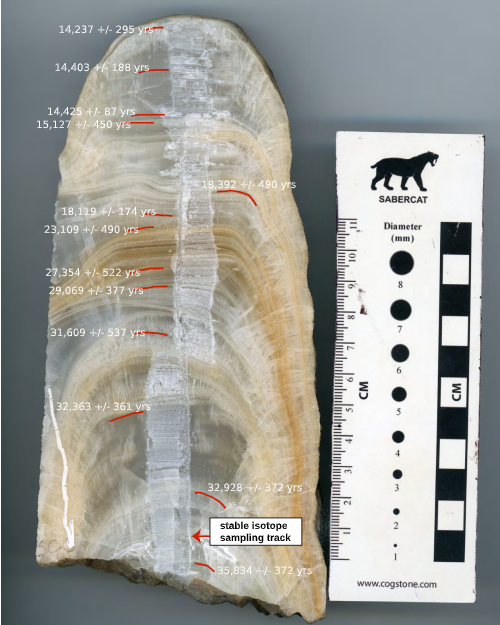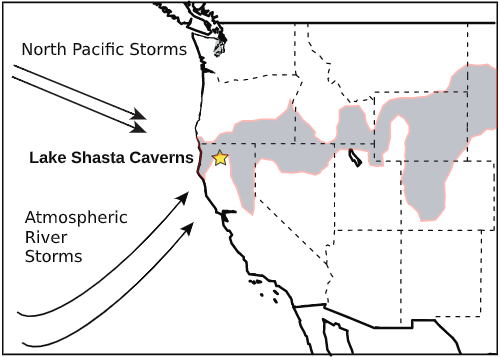Geochemical analysis from the last ice age may hold clues for future climate change and preparedness strategies
“Stalagmites from Lake Shasta Caverns (LSC) – located in northern California within an important transitional climate zone between the Pacific Northwest and southwestern United States – hold geochemical clues to help researchers understand how climate changed during the end of the last ice age (14,000 – 37,000 years ago) and predict what may happen amid climatic changes in modern times.
A type of speleothem, stalagmites are impressive rock formations made of calcium carbonate that grow upwards from cave floors. They can take thousands of years to grow; from water droplets that make the slow trip from rainwater through the earth and finally dripping through fractures on the ceilings of caves to the floor. Jessica Oster, associate professor of earth and environmental sciences and paleoclimatologist, measured the geochemical properties within the stalagmites, including the stable isotopes of oxygen and carbon at LSC to understand how climatic and environmental factors in the region changed during and after the last ice age.
The article, “Multi-proxy stalagmite records from northern California reveal dynamic patterns of regional hydroclimate over the last glacial cycle” was published online in the journal Quaternary Science Reviews on June 24. It is available for free download until August 13.

While scientists have been working for more than a century to reconstruct the climate history of the western U.S., the many mountain ranges and microclimates spanning the region contribute to large variations in past climate change in this area. It is notable to have a record from LSC in northern California because of its location at the boundary between the southwestern U.S. and the Pacific Northwest, two parts of the western US that experience different climates today and have responded differently to climate change in the past.
One benefit of speleothems as recorders of climate change is that they can be accurately and precisely dated by measuring isotopes of uranium and thorium trapped in the stalagmite as it grows. This very powerful dating tool works up to 500,000 years before present, much further into the past than radiocarbon dating, which maxes out at 50,000 years. Oster and her collaborators dated two stalagmites and analyzed their geochemistry. They found that the amount of rainfall at LSC varied rapidly in the past, concurrent with known climate changes during and after the last ice age that have been noted in other paleoclimate records throughout the Northern Hemisphere. They also found that there were periods of time when the climate near LSC was more similar to the climate of the Pacific Northwest, and other periods when it was more similar to the southwest, indicating that the location of the boundary between these zones may not always have been located where we understand it to be today.
The large and rapid variations in rainfall recorded in the LSC stalagmites demonstrate that climate in northern California is sensitive to changes happening elsewhere in the world, and that rainfall in this area may be capable of increasing or decreasing in response to relatively small changes in global climate. In particular, Oster was able to connect the climate changes identified at LSC, a National Natural Landmark located two and a half hours north of Sacramento, with those of the benchmark climate record for the Northern Hemisphere, the Greenland ice core records. It is plausible that if climate changes in Greenland and northern California were related back then, they may be related now (currently the Greenland Ice Sheet is rapidly melting).

“Our findings offer us clues about the behavior of the region’s climate system and what rainfall in California does in response to climate changes which may already be underway around the world,” said Oster. “We can use this research that looks backward to look forwards. This is tremendously important because the semi-arid environment around Lake Shasta Caverns is sensitive to changes in rainfall and nearby Shasta Lake is the state’s largest water reservoir. Any change in rainfall around Lake Shasta has the potential to impact water resources for the entire state of California.”
As we enter an unknown climate territory, large scale models that help orient the global community do not often provide enough information at a regional scale of what local communities should be prepared for. Having a strong paleoclimate record provides a valuable framework for understanding how a regional climate changed in the past and what might be coming in the future.
The project, which began as student Izzy Weisman’s master’s degree thesis and benefitted from the contributions of several of Oster’s undergraduate students, has opened the doors to future research including the development of quantitative reconstructions of how rainfall changed in the past, which will be of great use to local city and resource planners. This work is also of interest to environmental scientists examining responses to climate changes in regions with similar geological characteristics around the world.
Funding for the research was provided by the National Science Foundation (AGS-1554998), the National Geographic Foundation and the Geological Society of America. All the data from this research will be archived with the NOAA Paleoclimatology Database. ”
Article by Marissa Shapiro Jul. 14, 2020, 9:00 AM